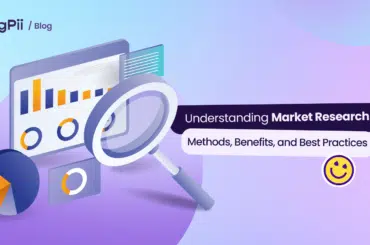Understanding the different methods of hypothesis testing is crucial for accurate data interpretation. Among these methods, one-tailed and two-tailed tests stand out due to their specific applications and implications.
This article discusses one-tailed vs two-tailed tests, their examples, scenarios where each test is applicable, and the pros and cons associated with one-tailed and two-tailed tests.
What is a One-Tailed Test?
One-tailed tests are used when a hypothesis predicts a specific direction of effect. They are ideal for scenarios where the interest lies in determining whether a parameter is significantly greater or less than a specific value.
This type of test evaluates whether the observed data deviates significantly from the null hypothesis (the hypothesis of no effect or no difference) but only in the specified direction.
In the context of A/B testing, a one-tailed test is used to determine if there is a significant difference in a specific direction between two webpage versions, products, or strategies.
For example, if you conduct an A/B test to see if a new website design leads to higher user engagement compared to the current design, a one-tailed test would be used to assess if the new design increases engagement specifically, ignoring the possibility of a decrease.
This focused approach makes one-tailed tests suitable for scenarios where you expect a directional and clearly defined outcome.
Example of a One-Tailed Test in A/B Testing:
Suppose an e-commerce company wants to increase its website’s conversion rate. The CRO team they hired hypothesizes that changing the color of the “Add to Cart” button from blue to red will lead to more clicks and, consequently, more purchases. To test this hypothesis, they set up an A/B test:
Version A (Control): The original webpage with the blue “Add to Cart” button.
Version B (Variant): The same webpage but with the red “Add to Cart” button.
The hypothesis predicts the red button will increase conversions. The null hypothesis (H0) states there will be no increase, or possibly a decrease, in conversions with the red button.
A one-tailed test checks for increased conversions with the red button. If the test shows statistical significance, it supports the hypothesis that the red button performs better. If not, there’s insufficient evidence to reject the null hypothesis, meaning the increase isn’t statistically significant.
Pros of one-tailed tests
-
Increased Power
One-tailed tests have more statistical power compared to two-tailed tests when testing the same hypothesis. They focus all statistical power in one direction of the distribution (the direction of interest), making it more likely to detect an effect in that direction.
-
Lower Sample Size Requirement
Due to its increased power, a one-tailed test often requires a smaller sample size to achieve the same level of statistical significance as a two-tailed test. This is a significant advantage in practical scenarios where collecting large samples can be time-consuming or expensive.
-
Specific Hypothesis Testing
One-tailed tests are tailored for specific, directional hypotheses. This means they are ideal when the hypothesis makes a specific prediction about the direction of the effect. For example, if a hypothesis states that a new marketing strategy will increase sales, a one-tailed test is appropriate because it specifically looks for an increase in sales.
Cons of one-tailed tests
-
Risk of Missing Opposite Effect
One of the main drawbacks of a one-tailed test is the risk of missing a significant effect in the opposite direction of the hypothesis. Since the test is designed to detect an effect in one specific direction, it may overlook meaningful changes that occur in the other direction.
-
Bias Risk
Choosing a one-tailed test, especially after data collection, poses a risk of bias. Decisions should be based on strong theoretical grounds or prior evidence, not on a desire to achieve significant results.
-
Limited Insight
One-tailed tests provide less comprehensive insight compared to two-tailed tests. By focusing only on one direction, they may miss out on understanding the full spectrum of the effect being studied.
What is a Two-Tailed Test?
A two-tailed test is a statistical method used when the direction of the effect is not specified in the hypothesis; unlike a one-tailed test that looks for a significant effect in one specific direction, a two-tailed test checks for significance in both directions.
This type of test is useful when you are interested in detecting any significant difference, regardless of whether it is positive or negative.
A/B testing uses a two-tailed test to determine whether a statistically significant difference exists between two versions (A and B) without a predetermined direction of the expected outcome.
This approach is crucial when the goal is to ascertain any significant change, whether an increase or a decrease, in a key metric due to variations in the test.
For instance, a two-tailed test is appropriate if you test two different website layouts to see which one performs better in terms of user engagement without a specific hypothesis about which layout will be superior.
Example of a Two-Tailed Test in A/B Testing:
The same ecommerce company wants to evaluate the impact of a new product description format on its website. The company is unsure whether the new format will increase or decrease customer engagement, so they conducted an A/B test again.
Version A (Control): The original product page with the standard description format.
Version B (Variant): The same product page but with the new description format.
The hypothesis is: “The new format will significantly impact engagement,” without specifying the direction of this impact.
A two-tailed test is chosen to detect any significant change in engagement, whether an increase or decrease. It assesses if the new format leads to a statistically significant difference in engagement compared to the control.
If the test shows significance, it confirms the new format notably affects engagement, but further analysis is required to determine if the effect is positive or negative.
Pros of two-tailed tests
-
Detects Effects in Both Directions
The primary advantage of a two-tailed test is its ability to detect statistically significant effects in both directions. This means it can identify whether the tested variable has a positive or negative impact compared to the control.
-
More Conservative
A two-tailed test is considered more conservative than a one-tailed test because it divides the significance level across both ends of the distribution. This means that for a result to be considered statistically significant, it must meet a stricter criterion compared to a one-tailed test.
Cons of two-tailed tests
-
Reduced Power
One of the main drawbacks of a two-tailed test is its reduced statistical power compared to a one-tailed test. The power of a statistical test is its ability to detect an effect when there is one. In a two-tailed test, because the significance level is split between both tails of the distribution, it requires a stronger effect to reach statistical significance.
-
Larger Sample Size Needed
Due to its reduced power, a two-tailed test often requires a larger sample size to achieve the same level of statistical significance as a one-tailed test. This can be a significant challenge in research scenarios where gathering a large amount of data is difficult, time-consuming, or expensive.
-
Overly General
In A/B testing, a two-tailed test can be overly general when there’s already a strong theory predicting the direction of an effect. It checks for changes in both directions, which may not be necessary if you only expect an increase or decrease.
One-Tailed vs Two-Tailed Tests: Which Should You Choose?
When deciding between a one-tailed and a two-tailed test in A/B testing, the choice hinges on your hypothesis and what you aim to discover or prove. Both tests have their place, but their applicability depends on the specific context of your research question.
Understanding the differences between these tests, their applications, and their implications is vital for accurate data interpretation and effective decision-making in various testing scenarios.



